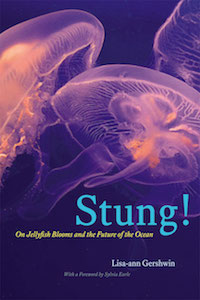Twice in my life have I eaten jellyfish; on both occasions I was in Japan at the time. Each time it was served as a salad and had the appearance of semi-translucent amber-colored noodles. The flavor was unremarkable – not unpleasant but not noteworthy either; however the texture was another matter entirely. Imagine eating a gummy bear that contained some extra mystery ingredient so that each bite yielded both a soft chewiness and an inexplicable crunchiness simultaneously. Needless to say, it is not something I would leap at the opportunity to sample a third time. Yet if the jellyfish population spikes described by Dr. Lisa-Ann Gershwin in Stung! On Jellyfish Blooms and the Future of the Ocean continue to increase, we may all find ourselves sitting down to a bowls of amber-hued crunchy gummy noodles on a regular basis as it may be one of the few types of seafood left to us.
Now, make no mistake, Stung! is far from the usual “sky is falling” fare that has become all-too-common on modern bookshelves. Dr. Gershwin’s point is not to frighten people but to educate them regarding a very real problem presently being observed throughout the world’s oceans and seas: various species of jellyfish are experiencing “blooms” (dramatic sudden increases in population) much larger and with greater frequency that at any previously recorded time. Such blooms are both the result of, and subsequently also an aggravating factor in, changes to the marine environment that are of great significance not only to that environment itself but to the ecological balance of he planet as a whole.
To make it clear just what is happening, and more important why it might be so, Dr. Gershwin draws upon her extensive experience as a marine biologist with particular expertise in the Cnidaria to explain the natural histories of a selection of these strange, beautiful, and potentially ecosystem-shifting creatures in language that is not only very clear and intelligible to the non-specialist reader but that is also delightfully literate and enjoyable to read in and of itself. Through the interweaving of accounts of observed blooms with explanations of the life cycles of her subjects, Dr. Gershwin offers her readers the opportunity to understand jellyfish as creatures in and of themselves as well as actors in a much larger – and increasingly unhealthy – ecosystem.
The main problem with jellyfish – at least from our perspective as humans (particularly humans with a taste for a seafood diet that draws heavily upon the top-level predators in both salt and fresh water environments) – is that they thrive in conditions that are unhealthy to the species we most prize; conditions that – as their population increases – they then contribute the worsening of by killing off and consuming (it’s difficult to use the verb “to prey” when the creature in question lacks a brain in any sense that would imply volition) the species that in a balanced ecosystem would normally prey upon the juvenile jellyfish themselves. In a sense, once they begin to bloom, they become a self-fulfilling prophecy.
Of course, the effect jellyfish blooms have upon the aquatic food chain is only a part of how they impact human activities. In their early stages of life they are nearly impossible to filter out of waterways and thus can achieve entry into the industrial water cooling systems of power plants. In their adult stage their gelatinous bodies can likewise clog and block similar systems. Their presence can pose a life-threatening danger to recreational use of seashores, and when discovered there, close beaches, thus yielding economic damage upon the communities surrounding them. They can even have consequences in matters of national defense, as in 2006 when the aircraft carrier U.S.S. Ronald Reagan was temporarily disabled while docked at the Port of Brisbane in Australia when its engines’ cooling systems became clogged with thousands of jellyfish.
Yet it is important to be clear, as Dr. Gershwin most certainly is throughout Stung!: jellyfish are not some unnatural malevolent force intent upon wreaking destruction upon the planet. They are, rather, a wholly natural part of their various ecosystems that are reacting to changes those ecosystems are experiencing. In a sense, rather than a plague, they are a harbinger of other changes yet to come. By understanding them – their life cycles, their activities, and the role they play in their environments – we can both immunize ourselves against the histrionics of the popular media (“Jellyfish Swarm Attacks Swimmer at Popular Beach Resort!”) and perhaps develop a better understanding of the deterioration of the planet’s aquatic ecosystems – and as a result perhaps enhance efforts to remediate the damage.
 Title: Stung! On Jellyfish Blooms and the Future of the Ocean
Title: Stung! On Jellyfish Blooms and the Future of the Ocean
Authors: Lisa-Ann Gershwin
Publisher: University of Chicago Press
Imprint: University of Chicago Press
Format: clothbound
ISBN: 9780226020105
Pages: 456
Date of Publication: 2013
In accordance with Federal Trade Commission 16 CFR Part 255, it is disclosed that the copy of the book read in order to produce this review was provided gratis to the reviewer by the publisher.
If you enjoyed reading this, please consider signing up for The Well-read Naturalist's newsletter. You'll receive a helpful list of recently published reviews, short essays, and notes about books in your e-mail inbox once each fortnight.
